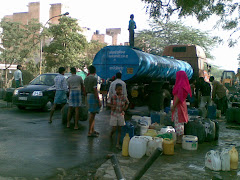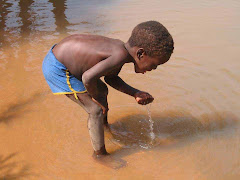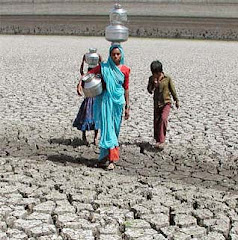The ongoing 15th annual United Nations Climate Change Conference (COP15) in Copenhagen, Denmark, is a failure for more reasons than one. Not only has the West and the others failed to arrive at a consensus so far, it has also left a crucial element out of the deliberations.
There has been no relevant mention of water on the agenda and this has caused the greens and experts to slam negotiators for their failure to recognize water as a crucial element while hammering out agreements on climate change.
Perhaps, the participants have managed to take out the single most important element to mitigating and adapting to climate change. It's what some are saying is like not talking about food shortage in the face of a famine.
It's unreasonable, no doubt. Climate change has already had demonstrable affect on global water supplies and in the future, more water stress is being predicted.
In fact, the 'UN World Water Development Report 3: Water in a Changing World', which was produced in anticipation of discussions at COP15, states that evidence of the impact of climate change on the earth’s hydrological cycle is mounting in many regions of the world, in the form of increased frequency of floods, droughts and other water hazards and changes in long-term trends in precipitation.
The report states that climate change is one of the basic drivers of change for water, besides demographic, economic, social and technological forces. "Climate change can affect water resources directly, but also indirectly through its impact on the other drivers", it adds.
Yet, COP15 managed to make just some customary do-good noise and effort about water. The conference organizers just managed to ensure that the meeting remains strictly a green one and the relevance of water was brought through serving only tap water instead of mineral water.
Delegates have also been told to bring their own cups, or use biodegradable cornstarch cups available on site. Plastic bottles will be a strict no. "If some people insist on drinking bottled water, we won't take it away from them. But we will really recommend them not to," Head of Sustainability for COP15 Jan-Christoph Napierski was quoted as saying in news reports.
But, critics feel, all this is mere posturing.
According to the Global Water Partnership (GWP) and the Global Public Policy Network on water management (GPPN), a joint initiative by Stakeholder Forum and the Stockholm International Water Institute (SIWI), water is the primary medium through which climate change impacts will be felt by human populations and the environment. Adapting to climate change will require adapting to changes in water availability and distribution.
The failure to recognise the role of water management in adapting to climate change has numerous and multifaceted repercussions for people's lives; It means that national water suppliers will not have access to sanitation systems that are resilient to flooding or unexpected weather events: It means that farmers will not have adequate information or resources to ensure that they can cope with diminishing rainfall: It means that new pressures will be put on already strained relations between neighbouring states who depend on shared water resources, a statement issued by GWP-GPPN stated.
For years to come, water would remain central to the world’s development challenges. And, lack of water, which will surely get exacerbated by climatic changes, is likely to hit future development milestones. Notwitstanding the mitigation efforts being carried out across the world, people will continue to experience the impacts of climate change through water.
It's time water gets its due in all talks on climate change.
Thursday, December 17, 2009
Tuesday, December 15, 2009
Water, a safe investment option.
The global water sector would remain a safe investment choice during 2010 and for several years beyond, a US-based investment management firm has said.
The consultancy, which tracks the water sector, and some of its top companies regularly, has identified water conservation and efficiency, recycling and reuse as the hot areas of investment in the sector.
A report from Summit Global Management entitled 'The Case for Water Equity Investing 2010' has stated that water being an underestimated resource, many might not realise that it represents the "world's third biggest (industry sector) in terms of embedded capital behind only oil & gas and electrical power", and the global market is estimated to be $500 billion per year.
The report said that the global economic crisis will undoubtedly impact the volume and rate of investment going into hydrocommerce in the near term. But the investment side of the industry has certainly evolved over the last 25 years, and the changes are virtually all positive.
Given the compelling, recession-resistant business model, combined with the urgency of water challenges across the globe, the consultancy is of the view that the outlook for water stocks today is much better than it was 25 years ago, or even five ago. Hydrocommerce will undoubtedly remain one of the world’s most vital industries, and will continue to offer some of the best risk/reward characteristics to the intelligent long-term investor, it added.
The findings of the report come as a shot in the arm for those looking at water as an investment option. Water scarcity is now a global issue. Going ahead, as climate changes come into play more strongly and affect supplies, population growth raises demand and pollution eats into already-scarce resources, it would be a profitable industry for those who come up with viable solutions.
The consultancy, which tracks the water sector, and some of its top companies regularly, has identified water conservation and efficiency, recycling and reuse as the hot areas of investment in the sector.
A report from Summit Global Management entitled 'The Case for Water Equity Investing 2010' has stated that water being an underestimated resource, many might not realise that it represents the "world's third biggest (industry sector) in terms of embedded capital behind only oil & gas and electrical power", and the global market is estimated to be $500 billion per year.
The report said that the global economic crisis will undoubtedly impact the volume and rate of investment going into hydrocommerce in the near term. But the investment side of the industry has certainly evolved over the last 25 years, and the changes are virtually all positive.
Given the compelling, recession-resistant business model, combined with the urgency of water challenges across the globe, the consultancy is of the view that the outlook for water stocks today is much better than it was 25 years ago, or even five ago. Hydrocommerce will undoubtedly remain one of the world’s most vital industries, and will continue to offer some of the best risk/reward characteristics to the intelligent long-term investor, it added.
The findings of the report come as a shot in the arm for those looking at water as an investment option. Water scarcity is now a global issue. Going ahead, as climate changes come into play more strongly and affect supplies, population growth raises demand and pollution eats into already-scarce resources, it would be a profitable industry for those who come up with viable solutions.
Labels:
hydrocommerce,
water investment,
water stocks
Tuesday, December 8, 2009
India's Tatas make foray in low-cost water purifier market
India's leading corporate Tata Group has launched a new low-cost water purifier targeted at the rural masses. The water filter is designed to be used in rural households that have no electricity or running water and would use ash from rice milling to filter out bacteria. The business group hopes it will provide safe drinking water for millions and cut the toll of deadly diseases.
The low-cost purifier will cost around Rs 1000 (or about $22) and should find easy acceptance among people in rural India. It's, of course, another matter that there are thousands of villages across India where water is just not available.
The scourge of water pollution not only affects India, but the entire world. According to the United Nations, more than one in six people worldwide, or 894 million, do not have access to clean water for their basic needs. Diarrhoea remains the leading cause of illness and death, particularly among children.
Nearly 90 per cent of deaths from diarrhoea are due to lack of sanitation, unsafe drinking water and water for hygiene. In India, 75 per cent of the rural population does not have access to safe drinking water.
The Tatas have befittingly called the new product Swatch (meaning pure, clear in Hindi). The product has come up after the group carried out extensive research. The group has reportedly invested Rs 1 billion in the project and set a target of selling three million units in the next five years.
A low-cost product is not new to the Indian market. The home water purification industry in India is a buoyant one and there are already several players, as also a few more low-cost water purifiers in the market. FMCG giant Hindustan Unilever had also rolled out its battery-operated Pureit model, which has a 4.5-litre capacity and can filter up to 1,500 litres.
Tata's Swatch has a 9.5-litre capacity and can filter 3,000 litres until the cartridge has to be replaced. The device uses tiny silver particles to kill harmful germs that can lead to diseases like diarrhoea, cholera and typhoid, something quite common in India.
The device meets the highest US Environmental Protection Agency standards and also removes micro-organisms, colour and odour. The group had tested it in 600 rural households across four Indian states before it was launched.
The low-cost water purifier market is expected to see some more roll-outs and product innovations in the years to come as water scarcity and pollution grow. It would also be a prudent business decision for all those in the industry, as the bottom of the pyramid offers a huge, huge potential market.
The low-cost purifier will cost around Rs 1000 (or about $22) and should find easy acceptance among people in rural India. It's, of course, another matter that there are thousands of villages across India where water is just not available.
The scourge of water pollution not only affects India, but the entire world. According to the United Nations, more than one in six people worldwide, or 894 million, do not have access to clean water for their basic needs. Diarrhoea remains the leading cause of illness and death, particularly among children.
Nearly 90 per cent of deaths from diarrhoea are due to lack of sanitation, unsafe drinking water and water for hygiene. In India, 75 per cent of the rural population does not have access to safe drinking water.
The Tatas have befittingly called the new product Swatch (meaning pure, clear in Hindi). The product has come up after the group carried out extensive research. The group has reportedly invested Rs 1 billion in the project and set a target of selling three million units in the next five years.
A low-cost product is not new to the Indian market. The home water purification industry in India is a buoyant one and there are already several players, as also a few more low-cost water purifiers in the market. FMCG giant Hindustan Unilever had also rolled out its battery-operated Pureit model, which has a 4.5-litre capacity and can filter up to 1,500 litres.
Tata's Swatch has a 9.5-litre capacity and can filter 3,000 litres until the cartridge has to be replaced. The device uses tiny silver particles to kill harmful germs that can lead to diseases like diarrhoea, cholera and typhoid, something quite common in India.
The device meets the highest US Environmental Protection Agency standards and also removes micro-organisms, colour and odour. The group had tested it in 600 rural households across four Indian states before it was launched.
The low-cost water purifier market is expected to see some more roll-outs and product innovations in the years to come as water scarcity and pollution grow. It would also be a prudent business decision for all those in the industry, as the bottom of the pyramid offers a huge, huge potential market.
Labels:
water filter,
water pollution,
water purification
Subscribe to:
Posts (Atom)

.jpg)


